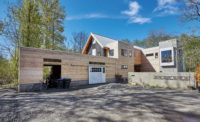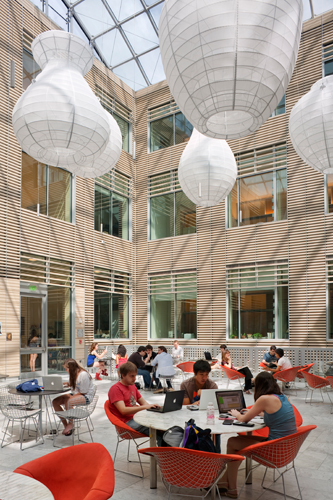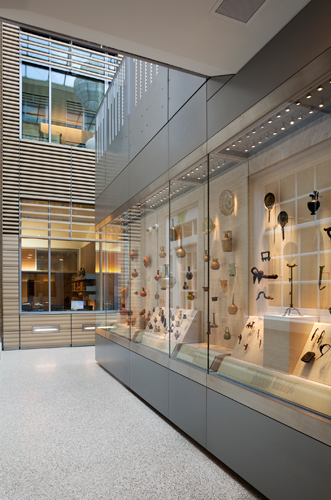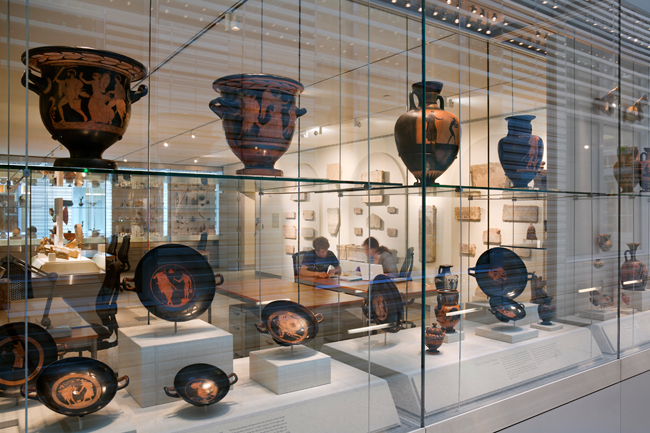Gilman Hall, Johns Hopkins University
Kliment Halsband replaces the void at the core of a stately building with a lively space for study and socializing.


















Architects & Firms
Baltimore
When a college expands and grows, building shiny state-of-the art facilities at its periphery, the oldest buildings at the heart of campus are sometimes neglected. Such was the case with campanile-topped Gilman Hall at Johns Hopkins University in Baltimore. The Federal style redbrick structure, built in 1915 to house the School of Arts and Sciences, occupied a privileged spot at the head of the main quadrangle. But despite its prominent location, Gilman, which included a library and four stories of office and classroom space around a courtyard, lacked basic infrastructure such as up-to-date climate-control systems and code-compliant stairs—that is, until the completion of a $58.6 million renovation last year by the New York City architects Kliment Halsband.
Not only were the facilities antiquated, but Gilman's space was underutilized: The 25,000 square feet of book stacks had sat almost completely empty since the construction of a new library in 1964. In addition, the courtyard, which included an enclosed passageway linking the main entry to a reading room, was inaccessible to occupants. It functioned as little more than a light well.
The client considered Gilman's exterior “a don't-touch zone,” according to Kliment Halsband partner Frances Halsband. However, her firm had more freedom on the interior. “We kept what worked, but were completely unsentimental about what didn't,” she explains. For example, the architects got rid of the old stacks, claiming the space for new faculty offices, seminar rooms, and administrative areas. And they reconfigured circulation, adding elevators and rebuilding stairs.
The renovation's boldest move was demolition of the courtyard passageway. Its removal allowed the transformation of the previously unusable core into a lively atrium, where students can chat or study. This new gathering space has a precisely engineered tension-grid skylight overhead, white marble salvaged from the old library stacks underfoot, and walls clad in buff terra-cotta panels. These conceal sound-absorptive material, softening what would have been an acoustically harsh environment.
Tucked underneath the atrium is a new archaeology study center. It is surrounded on all four sides by cases for the display of ancient pottery, glassware, and other artifacts and by an almost 8-foot-wide circulation zone open to the skylight above. In certain locations, anyone circumnavigating the study center can peer beyond the objects on view, through a second layer of glass, into the center's interior—a feature that has the effect of making the entire room into an oversized vitrine.
In Gilman's grand historic spaces, the architects' touch was much lighter. In the reading room, for instance, where colonnades separate an apselike area from a pair of side areas, they restored stained glass windows, replaced historically unsympathetic lighting with replicas of the original torchères and wall sconces, and disguised new mechanical systems in paneled millwork. They also inserted structural glass partitions behind the columns to acoustically divide the main and flanking spaces.
Much of the renovation work focused on improving environmental performance. In addition to the new building systems, changes such as the replacement of single-glazed wood windows with double-glazed versions and the furring out of perimeter walls for insulation have put Gilman on track for LEED Silver certification. Fortuitously, creation of the atrium should also help the building achieve its energy-saving goals, since covering the former light well reduces the size of the exterior envelope by almost one-third. However, the architects make no distinction between the efficiency measures and the conversion of a lifeless void into a social hub. Both efforts are intended to enhance the utility of the nearly century-old building, according to Halsband. “All of it,” she says, “is part of preparing Gilman for the next 100 years.”
Total construction cost: $58.6 million
Completion Date: June 2010
Gross square footage: 146,500
Architect:
Kliment Halsband Architects
322 Eighth Avenue
New York, NY 10001
212.243.7400 phone
212.633.9769 fax
info@kliment-halsband.com
www.kliment-halsband.com
PeopleOwner: Johns Hopkins University
Architect:
Personnel in architect's firm who should receive special credit:
Engineer(s): Structural: Robert Silman Associates (Washington, D.C. office) Telecom Engineer: RTKL
Consultant(s): Lighting: Tillotson Design Associates Acoustical: Acoustical Design Collaborative, Ltd. Gridshell Consultant: Schlaich Bergermann and Partner LP Donor Signage Consultant: C&G Partners Artist: Kendall Buster Art Consultant: Nancy Rosen LEED Consultant: Steven Winter Associates, Inc. Audio/Visual Consultant: Technology Design Resources LLC Cost Estimating Consultant: Faithful + Gould Elevator Consultant: Van Deusen and Associates Code Consultant: Koffel Associates General contractor: Lend Lease Construction
Photographer(s) Renderer(s): Brian Burr CAD system, project management, or other software used: AutoCad |
Products
Structural system Manufacturer of structural components unique to this project: Tension Grid Skylight System – Novum Structures, LLC
Exterior cladding Moisture barrier: Grace Construction Products Curtain wall: EFCO Roofing Elastomeric: EPDM – Firestone Metal: Copper dormers, bell tower & dome – Revere Copper & Brass Tile/shingles: Slate – North Country Slate
Windows Metal frame: Interior atrium windows: EFCO
Glazing Skylights: Tension Grid Skylight Glazing: Novum Structures LLC
Other: Patterned Glass at Interior Partitions: Bendheim Structural Glass Wall System - Structural Glass Wall: Oldcastle BuildingEnvelope
Doors Exterior Solid Wood doors: Harring Doors Fire-control doors, security grilles: Horizontal and Overhead Coiling Fire Shutters – Overhead Door Corp.
Hardware Closers: Hager; LCN Closers Exit devices: Von Duprin Pulls: Hager Other special hardware: Front entrance door pulls – Forms + Surfaces
Interior finishes Suspension grid: USG Cabinetwork and custom woodwork: Ilex Woodworking Paints and stains: Sherwin Williams Acoustic Wood Paneling: Decoustics Plastic laminate: Formica Solid surfacing: Corian Floor and wall tile: Toilet Rooms -Daltile Carpet: Karastan;Mohawk
Special interior finishes unique to this project: Roll Down Shades – Mechoshade Interior Stonework – Hilgartner Natural Stone Company Terrazzo – Roman Mosaic & Tile Company Terracotta Atrium Wall Cladding – NBK Terracotta by HunterDouglas
Furnishings Atrium furniture: Bertoia Diamond Chair; Vignelli Café Table; D’Urso Coffee Table Fixed seating: Theater Solutions; Knoll upholstery Historic Classroom/Reading Room Furniture: Palmieri Tables; Agati Prairie Chair Chairs: Bertoia Diamond Chair; Agati Prairie Chair; Mies van der Rohe Krefeld-inspired chair by David Edward Tables: Palmieri Tables; Vignelli Café Table; D’Urso Coffee Table; Florence Knoll Coffee Table
Lighting Classroom Lighting: Gammalux Atrium Lighting: Sistamalux Historic Replica Lighting: Rambusch Dimming System: Lutron Daylighting System: Sensor Switch
Conveyance
Plumbing
Energy
Add any additional building components or special equipment that made a significant contribution to this project: Archaeology Custom Vitrines – Helmut Guenschel |














